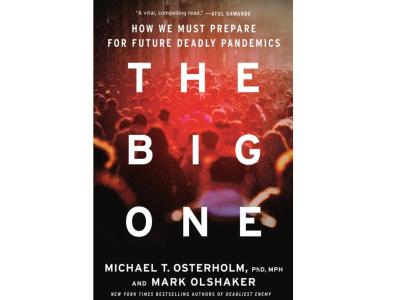Sep 2, 2009 (CIDRAP News) When a novel H1N1 influenza virus meets up with a seasonal flu virus inside an animal, the novel virus is likely to outdo the seasonal strainand unlikely to mix with it, according to a report published yesterday.
When scientists infected ferrets with the pandemic virus and one of two seasonal flu strains, the pandemic virus multiplied faster than the seasonal strain, caused more severe disease, and spread more easily to other ferrets. The team found no signs that the strains reassorted (mixed) to create new hybrids.
The report was published by PLoS Currents: Influenza, a Web site for rapid communication of flu findings; reports are screened by experts but not fully peer reviewed. The study was supported by the National Institute of Allergy and Infectious Diseases (NIAID).
"These findings suggest that while 2009 H1N1 virus probably will predominate in the coming flu season, there may not be biological pressure for the new virus to re-combine with other circulating viruses, the researchers say," the NIAID stated in a press release.
Novel H1N1 outpaces seasonal flu
In the study, an international team led by Daniel Perez of the University of Maryland used a California isolate of the novel H1N1 virus, a 2007 strain of seasonal H1N1, and a 2007 strain of seasonal H3N2.
Groups of ferrets were infected with just one of the viruses or with the novel H1N1 and either of the seasonal strains. Uninfected ferrets were housed with or near the infected ferrets to test for virus transmission by direct contact or by respiratory droplets.
Among the ferrets infected with just one virus strain, the novel H1N1 multiplied more abundantly, caused more severe illness, invaded the lungs more often, and spread to the uninfected ferrets more efficiently than the seasonal strains did, the team reports.
Ferrets that were inoculated with pandemic H1N1 and a seasonal virus mounted an antibody response against both viruses, but the response to the novel virus was more pronounced. Also, the directly co-infected ferrets shed the pandemic virus in greater quantities than the seasonal virus, and the pandemic strain spread to uninfected ferrets sooner than the seasonal strain did.
The team also found that only the pandemic virus appeared to spread from the directly co-infected ferrets to the other animals. In testing the latter group on the first and last days of viral shedding, the researchers found evidence of the pandemic strain only. And when nasal samples from the secondarily infected animals were used to infect still another group of ferrets, the new group likewise had only the novel virus.
Reassortment not favored
Some scientists have speculated that reassortment of the pandemic virus with a seasonal strain could give rise to a more dangerous virus. The researchers examined material from the nasal cavities of the directly co-infected ferrets and the contact ferrets but found no evidence of reassortment.
"Our studies show that the pandemic Ca/04 virus has a clear biological advantage in replication, transmission, tropism, and pathogenesis when compared to both seasonal H1and H3 representative strains," Perez and colleagues write.
Although findings in ferret studies must be interpreted cautiously, they add, "it is reasonable to speculate that this prototypical pandemic strain . . . has all the makings of a virus fully adapted to humans. At present, reassortment may not be particularly favored."
One caveat the authors add is that all their ferrets had a detectable, though low, level of antibodies to the seasonal flu strains before they were infected. Therefore, they can't entirely exclude the possibility that limited preexisting immunity to the seasonal strains helps explain the novel H1N1 virus's dominance. At the same time, the authors note that in ferrets infected only with the seasonal strains, those strains multiplied and spread effectively.
Findings parallel real-world experience
Dr. Richard Webby, an influenza expert at St. Jude Children's Research Hospital in Memphis, said the preexisting antibodies are unlikely to fully account for the results. Webby was not involved in the study, but he noted he is one of the moderators for PLoS Currents: Influenza and therefore is "a little bit biased."
"I doubt that those preexisting antibodies would be responsible for all of the effect seen, so I believe that the pandemic strain does have a competitive advantage," he told CIDRAP News. Webby is director of the World Health Organization Collaborating Center for Studies on the Ecology of Influenza in Animals and Birds at St. Jude.
The findings are consistent with what has happened recently in the southern hemisphere, where the pandemic strain has dominated the flu season in most places, Webby said. And as noted by the study authors, most people, like the ferrets, have some antibodies against seasonal flu strains, he added.
Webby said the finding of no reassortment is encouraging, mainly because it suggests a reduced risk of the pandemic virus becoming resistant to oseltamivir (Tamiflu).
"The most worrying aspect of potential pandemic and seasonal reassortment is the possibility that the pandemic strain could pick up the neuraminidase from the seasonal H1N1," he said. "The N from the seasonal H1N1 carries the marker for oseltamivir resistance."
However, the finding doesn't mean that reassortment can't occur, Webby said. The conditions used in the experiment are "one scenario where reassortment could occur, but there are many others. The natural test will occur over the next couple of flu seasons."
Another positive implication of the study, in Webby's view, is that the novel strain may replace one of the existing strains, instead of just adding to them. "When at least two of the last pandemics came in they did kick out the old one, so perhaps this may happen with this virus. It's a bit more fit and more able to spread, and it may potentially kick out one or both of the other strains circulating."
If that doesn't happen, it will complicate the making of flu vaccines, as they might have to target four flu strains, he added.
One other finding of the study was that the animals co-infected with novel H1N1 and seasonal H3N2 appeared sicker than those infected with novel H1N1 and seasonal H1N1, as they had diarrhea and weight loss. In view of this, the authors say, it is important to determine whether any of the fatal human cases have involved co-infections.
Webby commented that co-infections may have occurred in humans, but if they occurred in some of the severe cases, testing probably would have detected them.
Perez D, Sorrell E, Angel M, et al. Fitness of pandemic H1N1 and seasonal influenza A viruses during co-infection: evidence of competitive advantage of pandemic H1N1 influenza versus seasonal influenza. PLoS Currents: Influenza 2009 [Full text]
See also:
Sep 1 NIAID press release
http://www.niaid.nih.gov/news/newsreleases/2009/Pages/H1N1Advantage.aspx



















